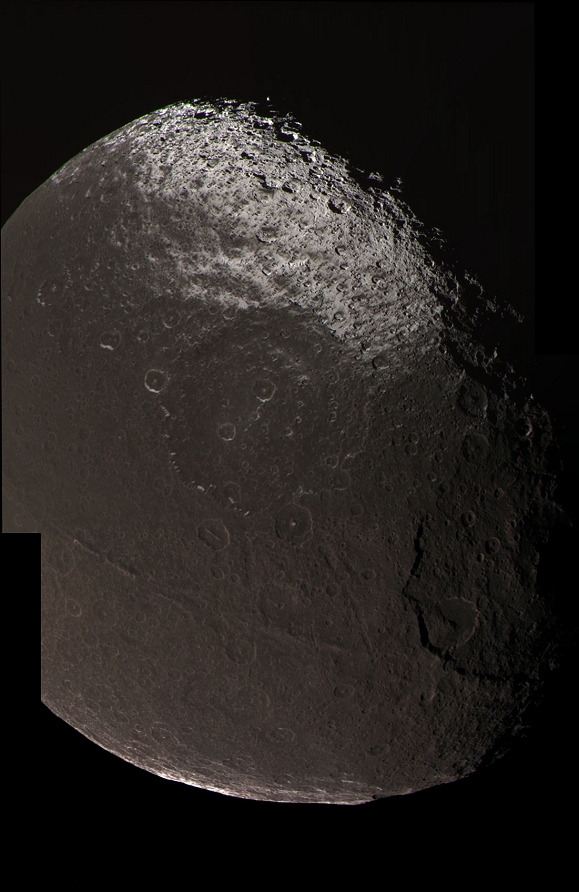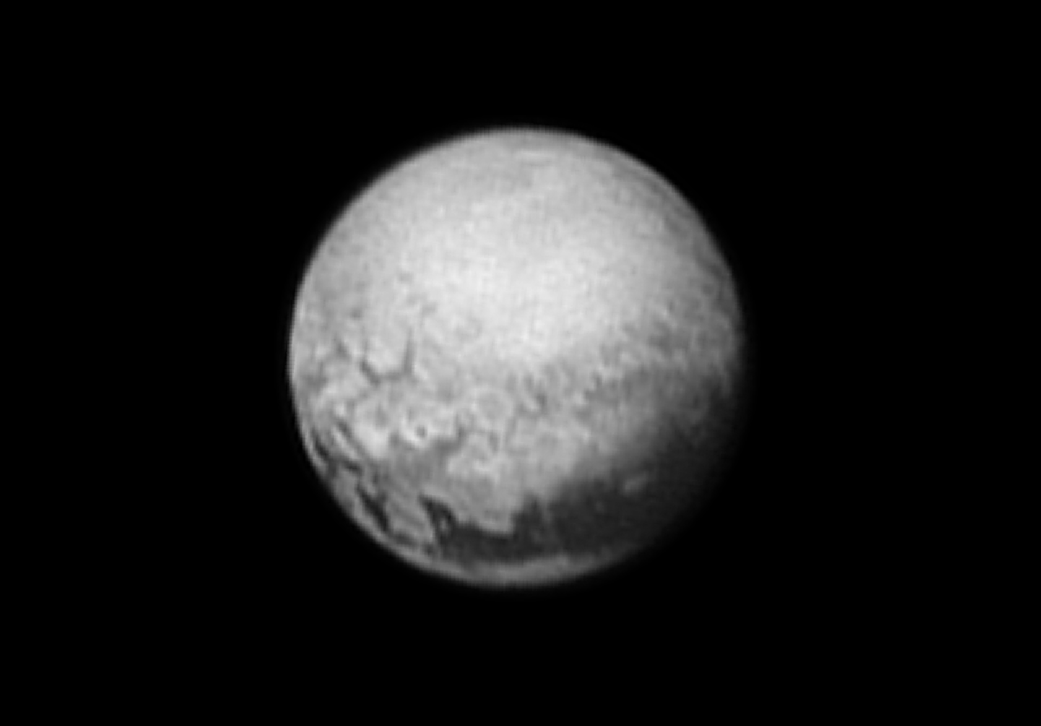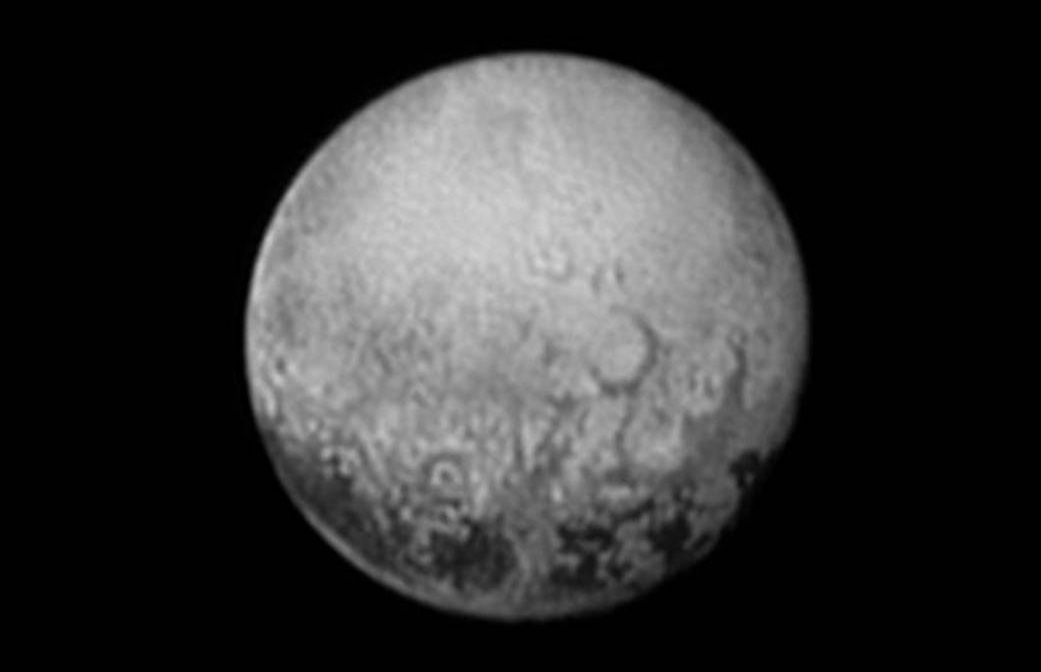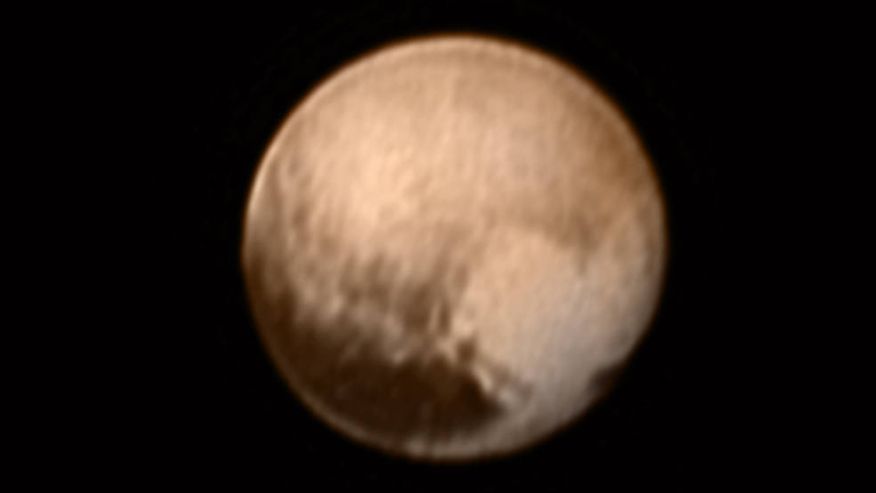It looks like you're using an Ad Blocker.
Please white-list or disable AboveTopSecret.com in your ad-blocking tool.
Thank you.
Some features of ATS will be disabled while you continue to use an ad-blocker.
share:
originally posted by: onebigmonkey
NASA have produced a map projection of the surface.
www.nasa.gov...
As it is centred on the bit the probe will see as it passes it doesn't show the markings as we've seen in the photos, so here's a quick rejig of it:
Thanks for rejiging it. It's interesting to note that the dark spots are directly opposite the large bright area on Pluto. The dark spots themselves seem to be part of the complex of the dark material stretched along the equator. I wonder what forces played role in the formation of that complex.
How does the location of the dark spots (and the bright area) relate to the side that always faces Charon?
edit on 8-7-2015 by wildespace
because: (no reason given)
The left lobe of that 'heart' looks like three sides of a square to me. It also seems to have an alternating light-dark border on its two
leftward-facing sides, if you look closely.
I think this looks much more interesting - the long squiggly feature above the dark patch. Here it is sharpened up:


originally posted by: jaffo
I never in my life thought it would be this color, you know? I mean you grow up always thinking of it as blue or some other dark color. No idea why, but I always did. . .
A lot of distant objects in the Solar System have a dark red-ish coating of hydrocarbons that formed under the influence of cosmic and solar radiation.
A very prominent example of that is Saturn's moon Iapetus:

The dark spots are gradually coming into view in the latest, higher-rez images of Pluto:
www.nasa.gov...

As I suspected, the spots are turning out to be somewhat more complex and varied features, rather than the regular spots they appeared in the low-rez images.

As I suspected, the spots are turning out to be somewhat more complex and varied features, rather than the regular spots they appeared in the low-rez images.
a reply to: wildespace
I'm interested to see what the hexagonal shape is when they get closer.
The dark spots are cool and caught my attention as we got closer,
but now there is a hexagon visible!
Exciting!
I'm interested to see what the hexagonal shape is when they get closer.
The dark spots are cool and caught my attention as we got closer,
but now there is a hexagon visible!
Exciting!
originally posted by: Darkblade71
a reply to: wildespace
I'm interested to see what the hexagonal shape is when they get closer.
The dark spots are cool and caught my attention as we got closer,
but now there is a hexagon visible!
Exciting!
Hexagons are fairly common in nature, and are usually the result of something trying to expand into the surrounding area that offers resistance, or the surrounding area pushing in into the cetral area and meeting a resistance. Examples being impact craters, or atmospheric storms. The hexagonal feature seen on Pluto might be the remnant of an impact crater.
originally posted by: jaffo
originally posted by: angryhulk
The recent image of a heart shape on Pluto is intriguing.
Source
I never in my life thought it would be this color, you know? I mean you grow up always thinking of it as blue or some other dark color. No idea why, but I always did. . .
Same here. It look yellow-ish to me, but NASA is saying reddish-brown. But that just doesn't do it for me; maybe light reddish-brown? I suppose it's like Mars. The space pictures show a light salmon color, distantly reddish, but surface pictures often show deep red fog. Anyway, when I was growing up I always thought of Pluto as a ball of dark cold ice.
I'm red-green colorblind so....
edit on 10-7-2015 by jonnywhite because: (no reason given)
originally posted by: jonnywhite
originally posted by: jaffo
originally posted by: angryhulk
The recent image of a heart shape on Pluto is intriguing.
Source
I never in my life thought it would be this color, you know? I mean you grow up always thinking of it as blue or some other dark color. No idea why, but I always did. . .
Same here. It look yellow-ish to me, but NASA is saying reddish-brown. But that just doesn't do it for me; maybe light reddish-brown? I suppose it's like Mars. The space pictures show a light salmon color, distantly reddish, but surface pictures often show deep red fog. Anyway, when I was growing up I always thought of Pluto as a ball of dark cold ice.
I'm red-green colorblind so....
When astronomers describe something as "reddish" they mean that it reflects more in the longer wavelengths than in shorter wavelenghts. In practice, that could mean anything between deep red and yellow.
As I have mentioned earlier, many bodies in the outer Solar System have patches or a global coating of hydrocarbons formed by the cosmic or solar radiation, and that gives them the reddish hue. Ice can be seen where it had either solidified down from the atmosphere, or got exposed from underneath by impacts or tidal forces.
a reply to: wildespace
Do you think most of hte features we're seeing in the pictures of Pluto are surface or atmospheric in nature? Right now I'm not sure whether I"m looking at ground or "clouds" which is disorienting.
Googled this:
www.space.com - Lifting the Veil on Pluto's Atmosphere...
Do you think most of hte features we're seeing in the pictures of Pluto are surface or atmospheric in nature? Right now I'm not sure whether I"m looking at ground or "clouds" which is disorienting.
Googled this:
www.space.com - Lifting the Veil on Pluto's Atmosphere...
When astronomers graph the light data, a careful look at the gradual dimming of starlight shown in the occultation light curve reveals a "slight bend," or "kink." You can also see from the light curve that starlight does not penetrate all the way to Pluto's surface. Starlight did not reach the surface, suggesting that obscuring clouds and/or haze might mask the surface.
Yet another surprising discovery would be cryovolcanism — volcanic eruptions of gaseous material such as water, ammonia or methane — on Pluto. But recent observations have led astronomers to speculate exactly that. While Pluto's upper atmosphere has exhibited little change between 1988 and 2013, its lower atmosphere has shown otherwise. Pluto's light curve shows a bend near the bottom, but in more recent observations, the curve at the bottom begins to look bowl-shaped.
The increasing curvature means the atmosphere near Pluto's surface is increasing in pressure, and that a haze is covering its surface. Because of these extreme changes, astronomers have speculated that the cause may be cryovolcanism.
edit on 10-7-2015 by jonnywhite because: (no
reason given)
*UPDATE*
Below is a new, higher res photo of the dark spots. We should start seeing better images on the daily now that New Horizons is blazing ever so close to it's pass by of Pluto. This is a historical event as Pluto is the last frontier of our known Solar System. The only planet we have not been to yet.


Article from Gizmodo
Below is a new, higher res photo of the dark spots. We should start seeing better images on the daily now that New Horizons is blazing ever so close to it's pass by of Pluto. This is a historical event as Pluto is the last frontier of our known Solar System. The only planet we have not been to yet.


Article from Gizmodo
At this point, it’s safe to say that we’re going to be receiving a new ‘highest resolution image ever’ of Pluto on a close to 24 hour basis. Yesterday, we got our first peek at geologic features on the dwarf planet’s surface. And today, New Horizons beamed back the best image to date of four mysterious dark splotches near Pluto’s south pole.
The image above was captured when the New Horizons spacecraft was a mere 2.5 million miles from Pluto, and over 3 billion miles away from the Earth.
The dark spots appear on the hemisphere that always faces the moon Charon—the same side that’ll be invisible when New Horizons makes its closest approach on July 14th. Each one is now estimated to be roughly 300 miles across, and we haven’t a darn clue what they are. But, when this image is combined with composition and color data New Horizons hasn’t yet sent back, the Geology, Geophysics and Imaging team is hopeful it’ll be able to solve the mystery.
“It’s weird that they’re spaced so regularly,” said New Horizons program scientist Curt Niebur in a statement. Jeff Moore of NASA’s Ames Research Center agrees. “We can’t tell whether they’re plateaus or plains, or whether they’re brightness variations on a completely smooth surface.”
What could the dark splotches be? What’s up with the whale tail? Why is Pluto red? We’ll have answers to these questions and many, many more, by Pluto tomorrow.
originally posted by: SgtHamsandwich
*UPDATE*
Below is a new, higher res photo of the dark spots. We should start seeing better images on the daily now that New Horizons is blazing ever so close to it's pass by of Pluto.
But, unfortunately, this is the last hihg-rez view of the "mysterious spots" that we're gonna get from this mission. That part of Pluto's surface is rotating out of spaceraft's view, and the spacecraft will see a different part of Pluto during the closest approach. It might turn around and observe the spots again on its way out, but the image will be again low-rez.
I really wish New Horizons had a trajectory that would take it between Charon and Pluto - that way it would be able to photograph and study the dark spots (because they are on the side facing Charon) and get some great close-ups of Charon too.
it looks like the moon..
Aren't planets majestic? Even the ugliest ones.. I know pluto, us not a planet anymore, but to me will always be the 9th..
This object is so far away from us, and we have a probe, made of the universe flying out to look at another part of it millions of millions of miles away..
TO me this is just amazing..
Aren't planets majestic? Even the ugliest ones.. I know pluto, us not a planet anymore, but to me will always be the 9th..
This object is so far away from us, and we have a probe, made of the universe flying out to look at another part of it millions of millions of miles away..
TO me this is just amazing..
originally posted by: SgtHamsandwich
*UPDATE*
Below is a new, higher res photo of the dark spots. We should start seeing better images on the daily now that New Horizons is blazing ever so close to it's pass by of Pluto. This is a historical event as Pluto is the last frontier of our known Solar System. The only planet we have not been to yet.
(....)
Correction: Pluto is a dwarf planet and is within the Kuiper belt which is just beyond the planets in the inner solar system. Ceres is also a dwarf planet, but doesn't have the distinction of being in the Kuiper belt.
en.wikipedia.org - Kuiper belt...
And there're a few other dwarf planets for us to explore--like: Makemake, Eris, Haumea---and possibly some additional, but they're more distant and of course everything on them is probably frozen stiff.
For me what's of interest is how this pertains to origins of life. What will we learn? I don't care about much else. Though tor somebody who studies planets and solar system formation, this is all like candy.
I guess it all ties together. Learning about planets and solar system formation will give us more insight into origins of life too. It's nigh impossible to separate them from life. Maybe life never forms in the outer regions of solar systems for various reasons related? Or maybe it always starts on the surface because of something tied to the sun or cosmic rays? Maybe it always needs a liquid. Maybe volcanoes are prerequisites. Etc. It's an endlessly interesting topic because it has vast implications for us--we're life after all.
I wonder if these dwarf planets and gas giants and moons will ever have value beyond scientific study or the search for life? Like to mine or colonize? I could see us possibly erecting settlements underground on our moon for various purposes, but on pluto or charon or other moons? Doubt it, unless it's merely sentimental. But who can know? Maybe someday travle through our solar system will be so frequent people routinely stop at these places for reasons we don't understand fully. I think comedy lite science fiction writers would have hte best luck with ideas. They're not too serious.
edit on 12-7-2015 by jonnywhite because: (no reason given)
new topics
top topics
-
Federal law trumps state and local law every time
Social Issues and Civil Unrest: 17 hours ago, 17 flags
active topics
-
Petition Calling for General Election at 564,016 and rising Fast
Political Issues • 94 • : Freeborn -
-@TH3WH17ERABB17- -Q- ---TIME TO SHOW THE WORLD--- -Part- --44--
Dissecting Disinformation • 3384 • : brewtiger123 -
BIDEN Admin Begins Planning For January 2025 Transition to a New President - Today is 4.26.2024.
2024 Elections • 59 • : WeMustCare -
DOJ Special Counsel Robert HUR Says JOE BIDEN Can Be ARRESTED After Jan 20th 2025.
Above Politics • 30 • : WeMustCare -
On Nov. 5th 2024 - AMERICANS Prevented the Complete Destruction of America from Within.
2024 Elections • 160 • : WeMustCare -
Results of the use of the Oreshnik missile system in Dnepropetrovsk
World War Three • 240 • : 777Vader -
Both KAMALA and OBAMA are on the Nov 5th 2024 Ballot - If One Loses - Both Lose.
2024 Elections • 9 • : WeMustCare -
How many people, in GENERAL, are musically inclined?
Music • 26 • : Huronyx -
Well, here we go red lines crossed Biden gives the go ahead to use long range missiles
World War Three • 395 • : annonentity -
Federal law trumps state and local law every time
Social Issues and Civil Unrest • 30 • : ADVISOR


